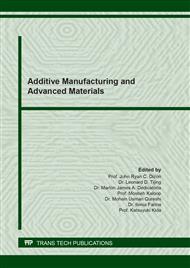[1]
D.N. Little, D.H. Allen, A. Bhasin, Modeling and design of flexible pavements and materials, Modeling and Design of Flexible Pavements and Materials. (2017) 1–693. https://doi.org/10.1007/978-3-319-58443-0.
DOI: 10.1007/978-3-319-58443-0_1
Google Scholar
[2]
A.T. Papagiannakis, E.A. Masad, Pavement Design and Materials, Pavement Design and Materials. (2012). https://doi.org/10.1002/9780470259924.
DOI: 10.1002/9780470259924
Google Scholar
[3]
M.U. Qureshi, A. Al-Hilly, O. Al-Zeidi, A. Al-Barrami, A. Al-Jabri, Vane shear strength of bio-improved sand reinforced with natural fibre, in: E3S Web of Conferences, EDP Sciences, 2019: p.12004. https://doi.org/10.1051/e3sconf/20199212004.
DOI: 10.1051/e3sconf/20199212004
Google Scholar
[4]
N. Al-Kindi, A. Al-Moqbali, M. Qureshi, A. Al-Shidi, I. Ala-Aldhen, Mechanical characteristics of recycled concrete aggregates as backfill material, International Journal of Applied Engineering Research. (2016).
Google Scholar
[5]
M. Aziz, F.N. Sheikh, M.U. Qureshi, A.M. Rasool, M. Irfan, Experimental Study on Endurance Performance of Lime and Cement-Treated Cohesive Soil, KSCE Journal of Civil Engineering. (2021). https://doi.org/10.1007/s12205-021-2154-7.
DOI: 10.1007/s12205-021-2154-7
Google Scholar
[6]
R.R. Singh, E.S. Mittal, Improvement of local subgrade soil for road constuction by the use of coconut coir fiber, IJRET: International Journal of Research in Engineering and Technology. (n.d.) 2321–7308. http://www.ijret.org (accessed November 11, 2021).
DOI: 10.15623/ijret.2014.0305131
Google Scholar
[7]
F.O. Festus, O.I. Adewuyi, Performance Evaluation of Forage Ash Stabilized Shale Soil for Effective Use in Flexible Pavement, Transportation Research Procedia. 48 (2020) 3648–3655. https://doi.org/10.1016/J.TRPRO.2020.08.084.
DOI: 10.1016/j.trpro.2020.08.084
Google Scholar
[8]
N.A. Akbar, T.N.H.T. Ismail, S.H. Adnan, F.M. Yusop, H. Khosran, N. Saji, Improvement in CBR Value of Sub-Base Soil using Concrete Slush Waste (CSW), Journal of Advanced Industrial Technology and Application. 1 (2020) 48–56. https://publisher.uthm.edu.my/ojs/index.php/jaita/article/view/6480 (accessed September 28, 2021).
Google Scholar
[9]
O. Mughieda, CBR behavior of sandy soil reinforced by geofiber material, IOP Conference Series: Materials Science and Engineering. 910 (2020). https://doi.org/10.1088/1757-899X/910/1/012005.
DOI: 10.1088/1757-899x/910/1/012005
Google Scholar
[10]
W. Wijaya, S. Ismanti, A. Rifa'I, Soft Clay Improvement Using Bamboo Leaf Ash on CBR Values, Journal of Physics: Conference Series. 1625 (2020) 012007. https://doi.org/10.1088/1742-6596/1625/1/012007.
DOI: 10.1088/1742-6596/1625/1/012007
Google Scholar
[11]
F. Maghool, A. Arulrajah, Y.-J. Du, S. Horpibulsuk, A. Chinkulkijniwat, Environmental impacts of utilizing waste steel slag aggregates as recycled road construction materials, Clean Technologies and Environmental Policy 2016 19:4. 19 (2016) 949–958. https://doi.org/10.1007/S10098-016-1289-6.
DOI: 10.1007/s10098-016-1289-6
Google Scholar
[12]
ASTM D1883 - 16 Standard Test Method for California Bearing Ratio (CBR) of Laboratory-Compacted Soils, (n.d.). https://www.astm.org/Standards/D1883 (accessed November 11, 2021).
DOI: 10.1520/d1883-07e01
Google Scholar
[13]
S. Roy, Assessment of Soaked California Bearing Ratio ValueUsing Geotechnical Properties of Soils, Resources and Environment. 6 (2016) 80–87.
Google Scholar
[14]
S. Muthu Lakshmi, S. Geetha, M. Selvakumar, Predicting soaked CBR of SC subgrade from dry density for light and heavy compaction, Materials Today: Proceedings. 45 (2021) 1664–1670. https://doi.org/10.1016/J.MATPR.2020.08.558.
DOI: 10.1016/j.matpr.2020.08.558
Google Scholar
[15]
S.R. Harnaeni, F.P. Pramesti, A. Budiarto, A. Setyawan, A preliminary study of mechanistic approach in pavement design to accommodate climate change effects, IOP Conference Series: Earth and Environmental Science. 129 (2018) 012037. https://doi.org/10.1088/1755-1315/129/1/012037.
DOI: 10.1088/1755-1315/129/1/012037
Google Scholar
[16]
A. Bharath, M. Manjunatha, T. Ranjitha B., T.V. Reshma, S. Preethi, Influence and correlation of maximum dry density on soaked & unsoaked CBR of soil, Materials Today: Proceedings. 47 (2021) 3998–4002. https://doi.org/10.1016/J.MATPR.2021.04.232.
DOI: 10.1016/j.matpr.2021.04.232
Google Scholar
[17]
ASTM D6913 / D6913M - 17, Standard Test Methods for Particle-Size Distribution (Gradation) of Soils Using Sieve Analysis, ASTM International, West Conshohocken, PA. Www.Astm.Org. (2017). https://www.astm.org/Standards/D6913 (accessed September 30, 2021).
DOI: 10.1002/ep.670180104
Google Scholar
[18]
ASTM D4318-17e1, Standard Test Methods for Liquid Limit, Plastic Limit, and Plasticity Index of Soils, ASTM International, West Conshohocken, PA. (2017). www.astm.org (accessed February 5, 2021).
Google Scholar
[19]
A. D698, Standard Test Methods for Laboratory Compaction Characteristics of Soil Using, ASTM Standard Guide. 3 (2003) 1–10. https://www.astm.org/Standards/D698 (accessed November 15, 2020).
Google Scholar
[20]
B.M. Das, Principles of foundation engineering : SI edition, (2015) 919.
Google Scholar


